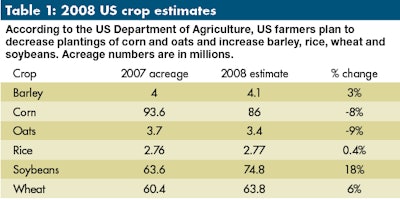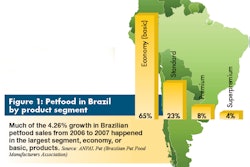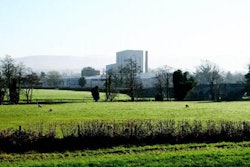
Petfood manufacturers worldwide have been dealing with soaring prices for ingredients - especially grain-based ones - for a couple of years. Is the situation likely to improve at all this year?
Not if corn is one of your key ingredients. According to the Prospective Plantings report from the National Agricultural Statistics Service of the US Department of Agriculture (USDA), US farmers are expected to plant 8% fewer acres of corn this year (Table 1). The 93.6 million acres planted in 2007 was the highest since 1944, as farmers capitalized on the demandand accompanying high prices, for corn to be used for ethanol production. (See http://usda.mannlib.cornell.edu/usda/current/ProsPlan/ProsPlan-03-31-2008.pdf . URL is case sensitive.)
Because of this demand, less corn was available for food and petfood production, and the price for what was available escalated. At the end of March, when the USDA report was released, a bushel of corn was trading on the Chicago Board of Trade for US$5.60, up from US$2 a bushel in 2006, according to an article in the Chicago Tribune .
The flip side
It's no wonder then, as an April 7 article in Time magazine pointed out, that US corn farmers now sell 20% of their crop to ethanol producers. Demand for new food sources from an emerging middle class in developing countries like China and India plays a role, too.
The flip side for farmers is that growing corn is expensive because of the need for intensive fertilization. Those high input costs, along with the need to rotate crop production in their fields, is what will drive US farmers to plant less corn this year, the USDA report says.
Another factor is that prices for other crops, such as soybeans, are also rising. It doesn't hurt that soybeans are less expensive for farmers to growthus, the projected 18% increase in soybean plantings this year (also in Table 1).
The wild card
Perhaps the most unpredictable yet possibly significant influence on crop production is the weather. In 2007 many parts of the US, including its farmland, were affected by drought. This year the biggest problem is just the opposite: heavy rains and flooding, especially in the Midwestern US, where much of the country's corn is grown.
Despite all these issues and the projected decrease in this year's plantings, the USDA expects corn acreage to remain at historically high levels. Whether petfood producers will be able to get their share - or afford it - remains to be seen.



.png?auto=format%2Ccompress&fit=crop&h=167&q=70&w=250)













